The Berkshires Bowling Alley that Inspired "The Big Lebowski"
It’s been 36 years since the release of The Big Lebowski, the irreverent cult comedy by Joel and Ethan


As the country is processing the passing of Supreme Court Justice Ruth Bader Ginsburg on Friday, her childhood growing up in Midwood, Brooklyn is coming back to light. Ruth Bader Ginsburg’s childhood home at 1584 E 9th Street, a few blocks off Ocean Parkway, has become a small makeshift memorial. Though not comparable in size to the tributes and memorials piling up at the Supreme Court in Washington D.C., the one here is small but strong – much like Ginsburg herself.
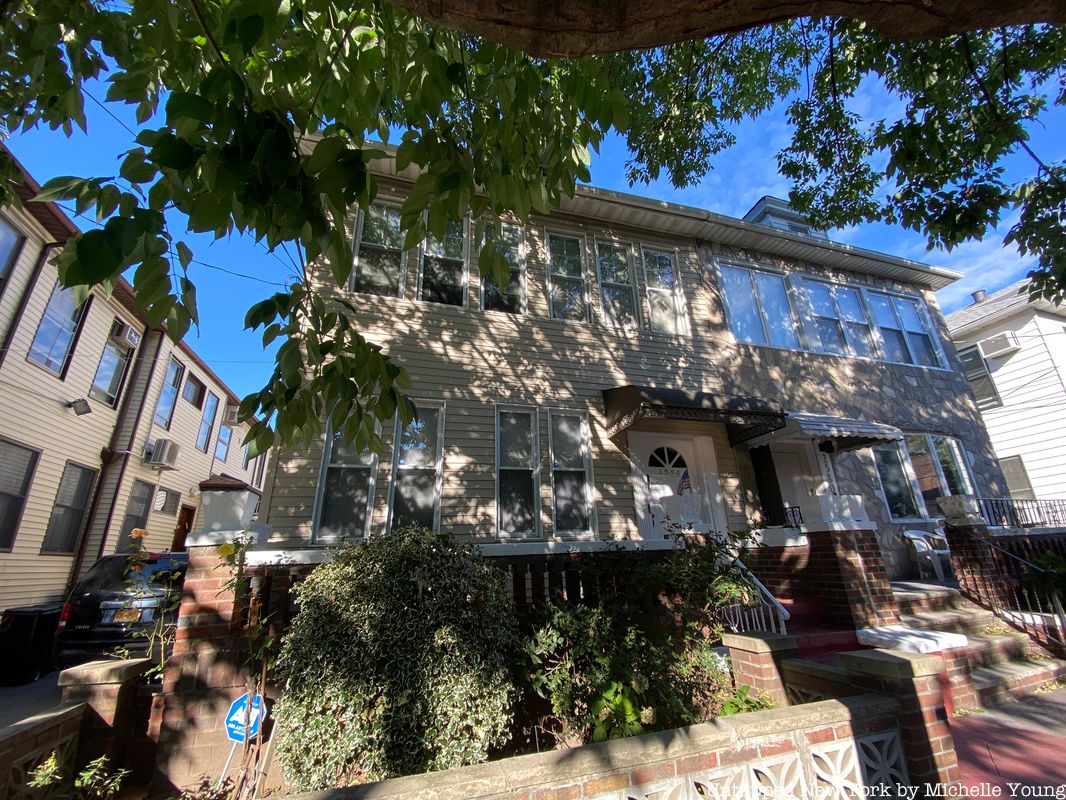
Ruth Bader Ginsburg’s childhood home in Midwood, Brooklyn.
Ginsberg was born in 1933 at what was then called the Beth Moses Hospital at 4802 10th Avenue in Borough Park. Today, the hospital is known as Maimonides Medical Center, named so after it merged with the United Israel Zion Hospital in 1947. Borough Park was settled by Jewish immigrants starting in the early 1900s, looking very much like the bustling Lower East Side. Today, it is very much associated with the Hasidic or Orthodox Jewish communities, but that shift only began in the 1980s.
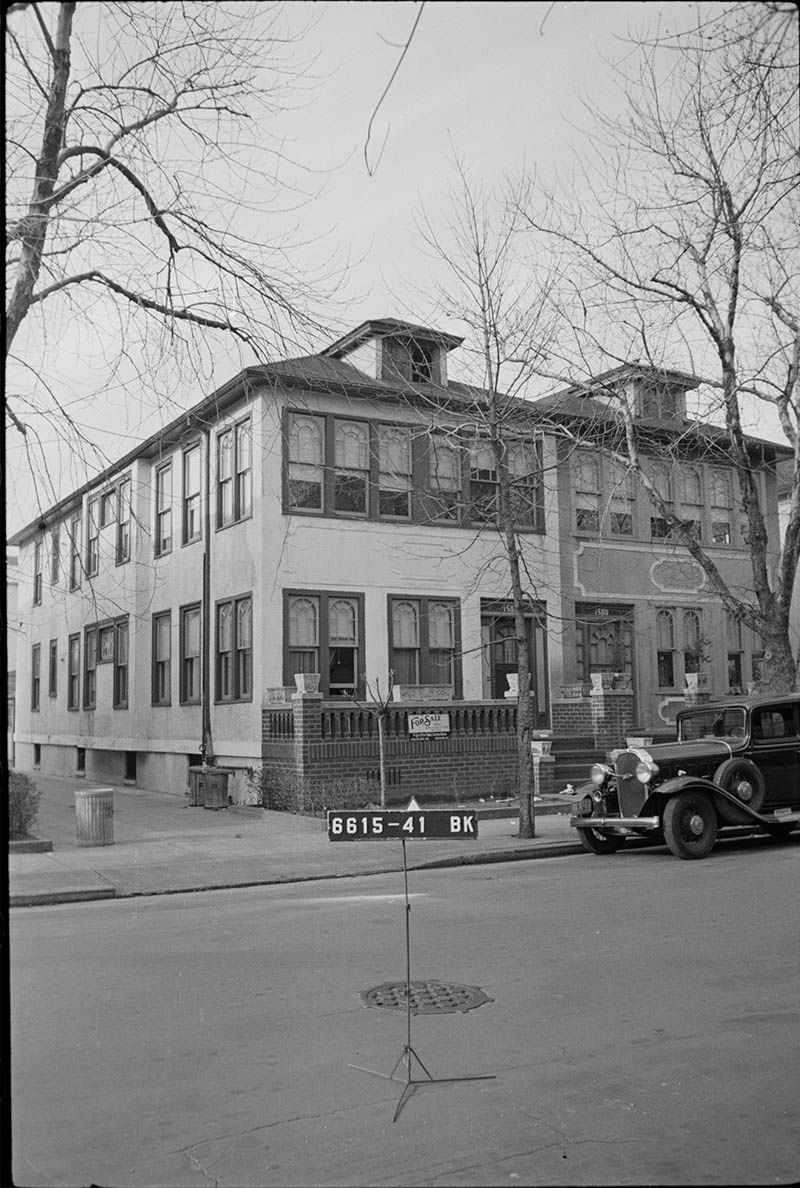
Ruth Bader Ginsburg’s childhood home in the 1940s. Photo courtesy Municipal Archives, City of New York
Ginsburg’s house at 1584 E. 9th Street was built in 1920. It’s one half of a two-family detached building. Looking at the 1940s tax photograph available at the NYC Municipal Archives, the house does not have the vinyl siding it has today, nor does the other half of the two-family house have the applied stone facade. In fact, both sides of the house appeared to have an outer facade layer possibly of stucco or “some sort of plaster,” architect Côme Menage of re-ad architecture & design tells us. There is a decorative band between the two floors on the front facade which is now either below the vinyl or has been lost.
The change in the windows is also quite significant. On the second floor, the windows were designed as one horizontal idea, linked together through the exterior window frames. Inside each window is an arched window inset, a design motif that was repeated on the front door. On the first floor, there were separate sets of windows but all windows have the same arched inset. On the side of the house, the windows closest to the street have been closed up and covered over.
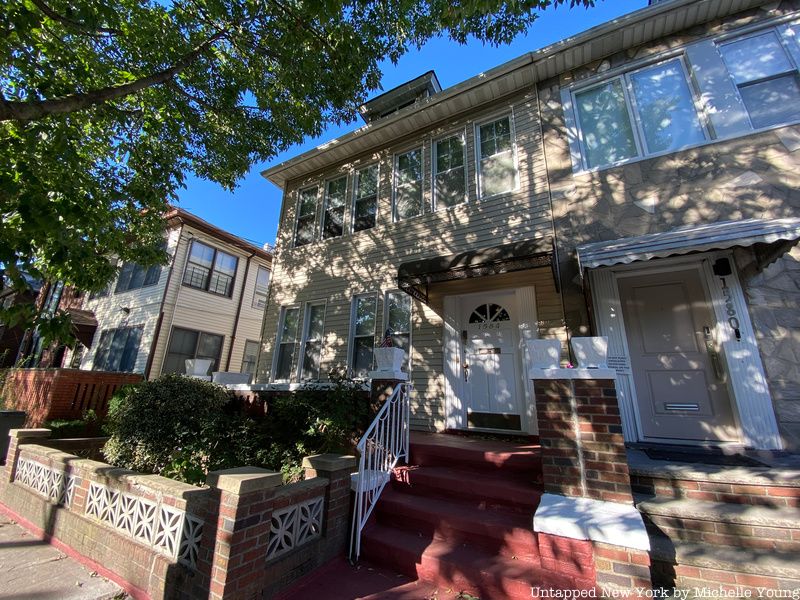
The house numbers were originally shown above the door frame and the door was framed by additional rows of glass panels. The brickwork in the small front yard has been extended closer to the sidewalk but it appears that the original porch and flower pots are still extant behind the shrubbery. In the 1940s tax photograph, the house has a For Sale sign — so Ruth Bader Ginsburg may have moved to another home shortly thereafter. Did the old-school car in front the house belong to the Ginsburg family? It’s fun to imagine. The current owners, Diana and William Brenneisen, have lived at the house for the last 47 years. William told WCBS Radio this weekend, “She was quite an inspiration, a very strong woman.”
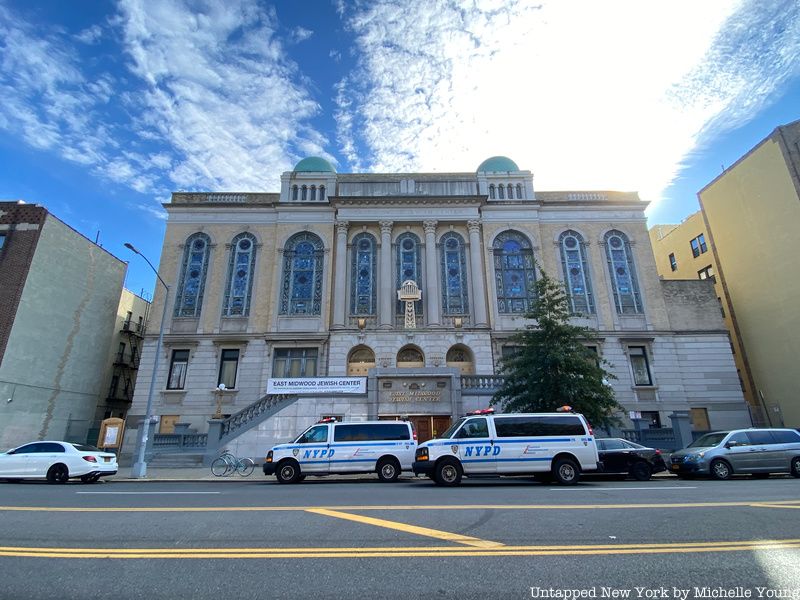
East Midwood Jewish Center
The Ginsburg family was from the working class — her mother was a garment factory worker and her father a furrier during the Depression. They were members of the East Midwood Jewish Center, found to be a better fit than the Reformed or Orthodox synagogues the family tried out before. In 2016, The Jewish Center posted an essay online by a 13-year old Ruth Bader that was originally published in the synagogue’s bulleting. The Jewish Center says that the essay, entitled “One People” urged “congregants to rid themselves of hate and prejudice.” The synagogue also says that Ginsburg, “wondered as a young girl why boys got to do a bar mitzvah at age 13, while ‘there was no comparable ceremony for me,’ a struggle that may have shaped her into the gender equality advocate she is today.”
Reflecting on World War II and the fate of European Jews in concentration camps, Bader wrote, in part, “In our beloved land families were not scattered, communities not erased nor our nation destroyed by the ravages of the World War. Yet, dare we be at ease? We are part of a world whose unity has been almost completely shattered. No one can feel free from danger and destruction until the many torn threads of civilization are bound together again. We cannot feel safer until every nation, regardless of weapons or power, will meet together in good faith, the people worthy of mutual association. There can be a happy world and there will be once again, when men create a strong bond towards one another, a bond unbreakable by a studied prejudice or a passing circumstance. Then and only then shall we have a world built on the foundation of the Fatherhood of God and whose structure is the Brotherhood of Man.” You can read the whole essay here.
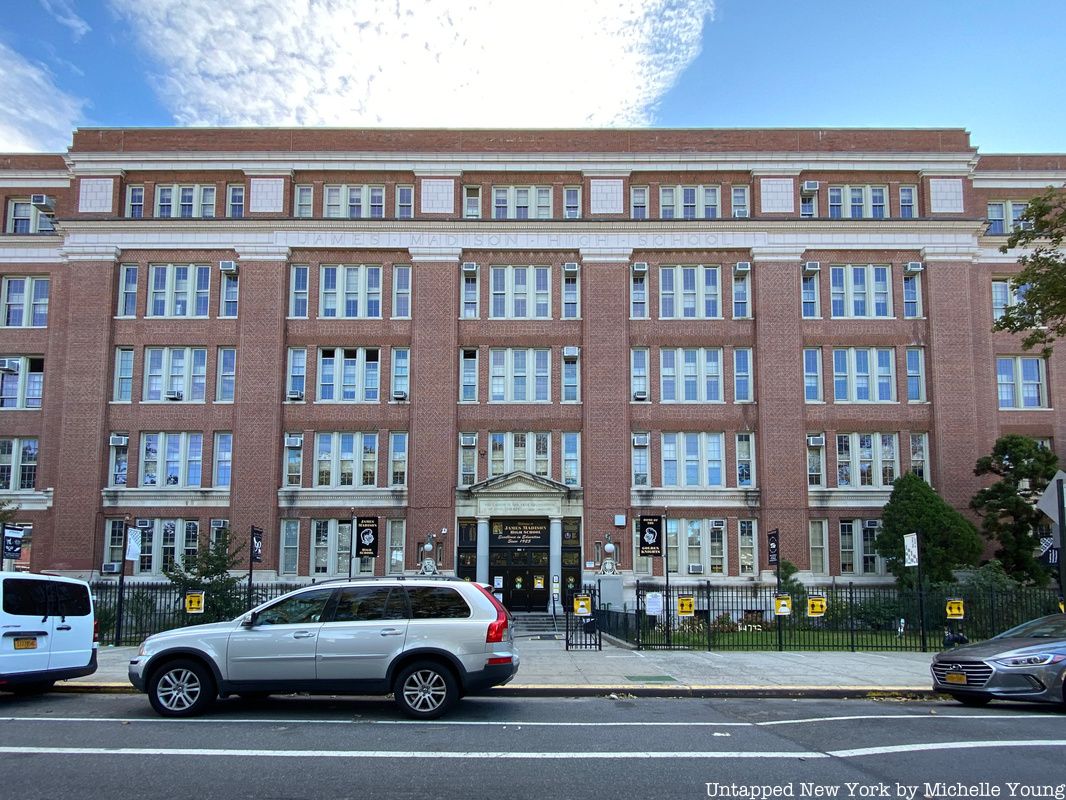
James Madison High School
Ruth Bader Ginsburg attended P.S. 238, just a three minute walk from her house on E. 9th Street and then James Madison High School a little under a mile away. She graduated sixth in her class from high school, but her mother died the day before her graduation after a long battle with cancer. Ginsburg’s mother had been a staunch supporter of her education, having missed out on going to college herself in order to allow her brother to attend.
New Yorker Simone Weissman, a real-estate agent with Compass, made a pilgrimage from her place in Manhattan to James Madison High School. She tells us that she “decided to go because my husband had heard on the radio that there was a memorial gathering going on at [James] Madison, although we saw only a reporter and a cameraperson in front. It was a safe, easy way to physically mark RBG’s passing—no large gathering or risk of police action in case anything got out of hand.”
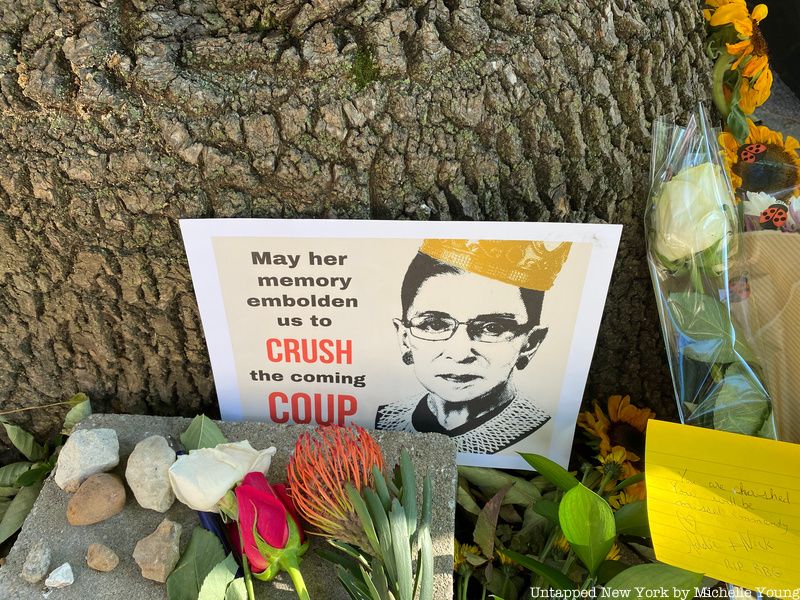
I had the opportunity to see Ruth Bader Ginsburg, and her fellow justices, during oral arguments at the Supreme Court on January 9, 2012 in the case Sackett v. The Environmental Protection Agency. This involved a family known as the Sacketts, who were suing the EPA regarding a compliance order. As the land was designated as wetlands, the order required the Sacketts to remove the rock and dirt they had infilled in order to build a house on their property.
Characteristic of a Supreme Court hearing, much of the discussion centered around how a particular law is applied, and if it had been done correctly. At the hearing, Ginsburg dove into unpack the question at hand. She asked, “What kind of review are you seeking? I mean, one thing you could say is you dispute that this property is subject to the [Clean Water] Act?” She continued to press whether the EPA had determined the land to be wetlands or not, and concluded with “But as far — as far the EPA is concerned, they’re finished with that question. This is not something that, well, we might look at it again tomorrow based on new evidence. The determination that these are qualifying wetlands — that has been made.” Justice Antonin Scalia was still alive at the time, and Justice Anthony Kennedy had not retired yet. Justice Clarence Thomas did not speak, and appeared to be sleeping, and I was told this was pretty standard! The court ended up voting unanimously that landowners, like the Sacketts, do not have a right to challenge a Clean Water Act order.
Sitting in on these hearings, you always wish you knew more about law than you do. The case did remind me a little of a landmark Supreme Court case I learned about in a land-use law class at Columbia University’s Graduate School of Architecture, Planning, and Preservation where I teach now. After graduating from James Madison High School, Ginsburg attended Cornell University where she excelled in her law program. At Cornell, she also met her future husband, Martin Ginsburg.
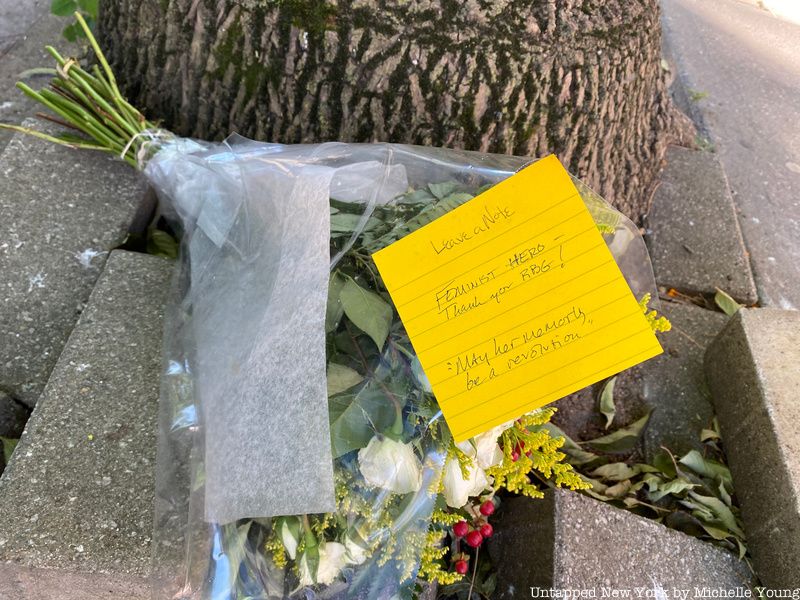
As well-documented in the documentary RBG and the film On the Basis of Sex, Ginsburg struggled with balancing career and family, but after taking time off to have children she went on to attend Harvard Law School during which Martin was diagnosed with cancer. She became the first female member of the Harvard Law Review. After Martin recovered and took a job in New York, Ginsburg was told she could not complete her studies from afar, so she transferred to Columbia University‘s Law School in her last year and finished her law degree.
This weekend, I too stopped by Ruth Bader Ginsburg’s old stomping grounds in Brooklyn— her house on E 9th Street, her high school, and her synagogue. It was ostensibly to take the photographs for this story, but since I had my daughter Charlotte in tow, it seemed like a good opportunity to share with my daughter who turned 3 on Saturday what we were doing there. I told her that Ginsburg said girls and boys can do the same things, and Charlotte laughed as if to say, “obviously!”. I told her that like Ginsburg, she was born in Brooklyn, and I hoped she would become a strong girl like the Supreme Court Justice was.
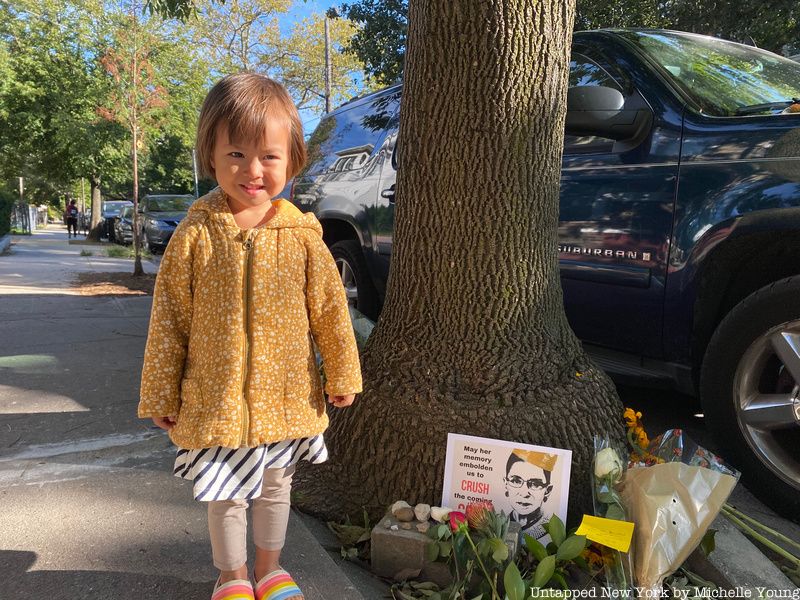
Charlotte Pasquet, my daughter, at Ruth Bader Ginsburg’s childhood home.
NY1 reported this weekend that a New Yorker named Megan Conn had biked to Ginsburg’s home Friday night to place an American flag. On our visit Saturday morning, it was in one of the planters. On the foot of the tree on the sidewalk in front of Ginsburg’s childhood home, flowers and notes had been left. One placard with an image of Ginsburg had the words “May her memory embolden us to crush the coming coup.” Others left Post-It notes and encouraged others to do so, with the words “May her memory be a revolution.”
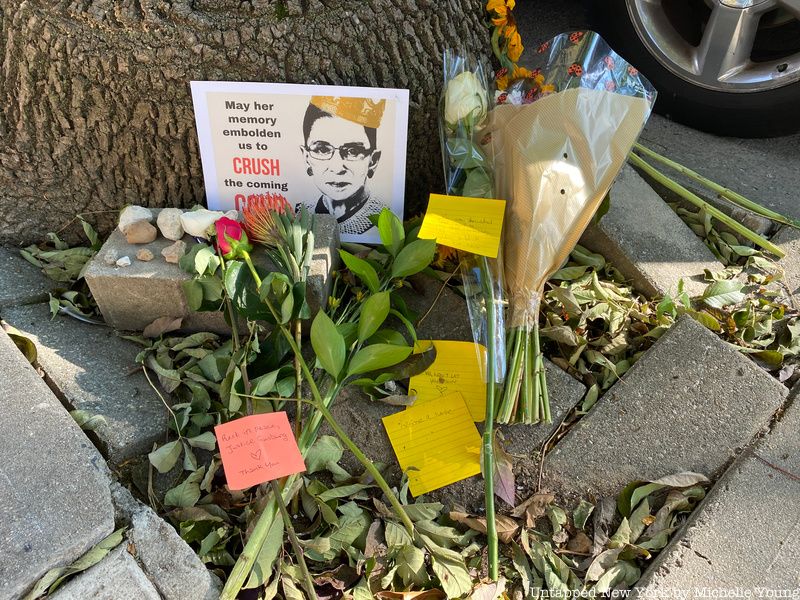
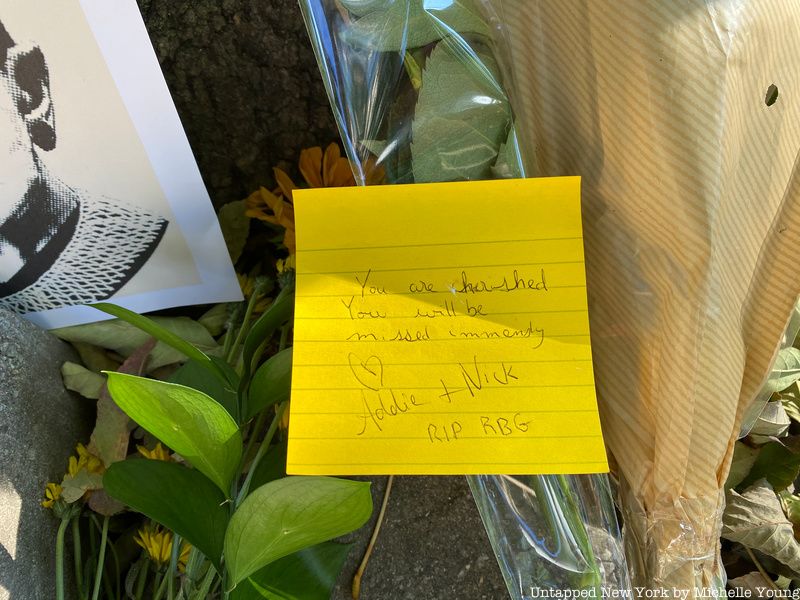
There is much debate at present about whether Ginsburg’s seat on the Supreme Court will be filled in an election year, a conversation that will dominate the news cycle. Here, we remember her roots in Brooklyn. New Yorkers are also taking to the subways and public spaces to create tributes. New York Governor Andrew M. Cuomo announced that he will start the process to create a memorial and statue in Brooklyn, stating “She was a daughter of Brooklyn and the embodiment of all that it means to be New York tough — yet her life was a testament that tough does not preclude acting with respect, grace, and dignity.”
One of the interesting finds in Borough Park is Torah Animal World, the museum featuring taxidermy versions of all the animals in the Torah. The Hasidic-run B-110 bus which runs as a franchise within the city bus system connects Borough Park with Williamsburg. Midwood is also home to the former Vitagraph Studios, a precursor to Hollywood. You can still see some remnants, like an old smokestack.
Subscribe to our newsletter